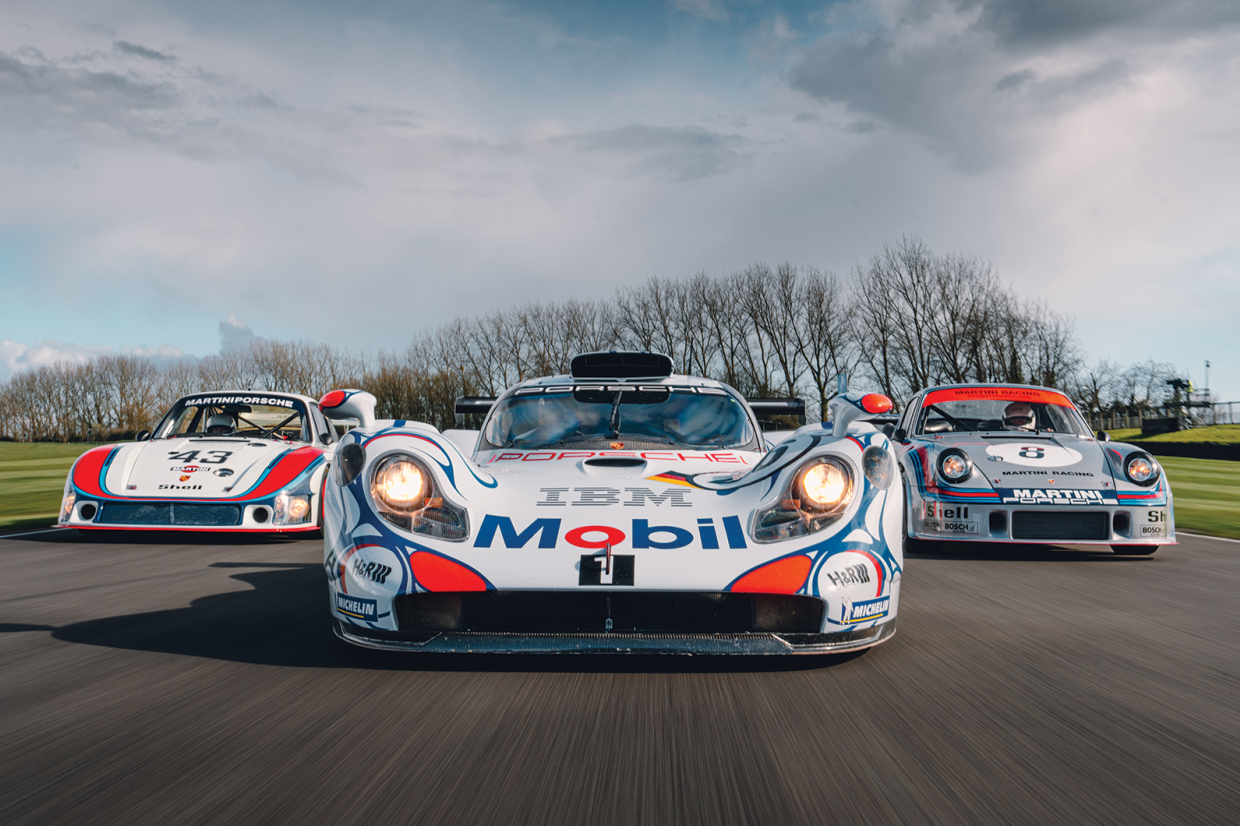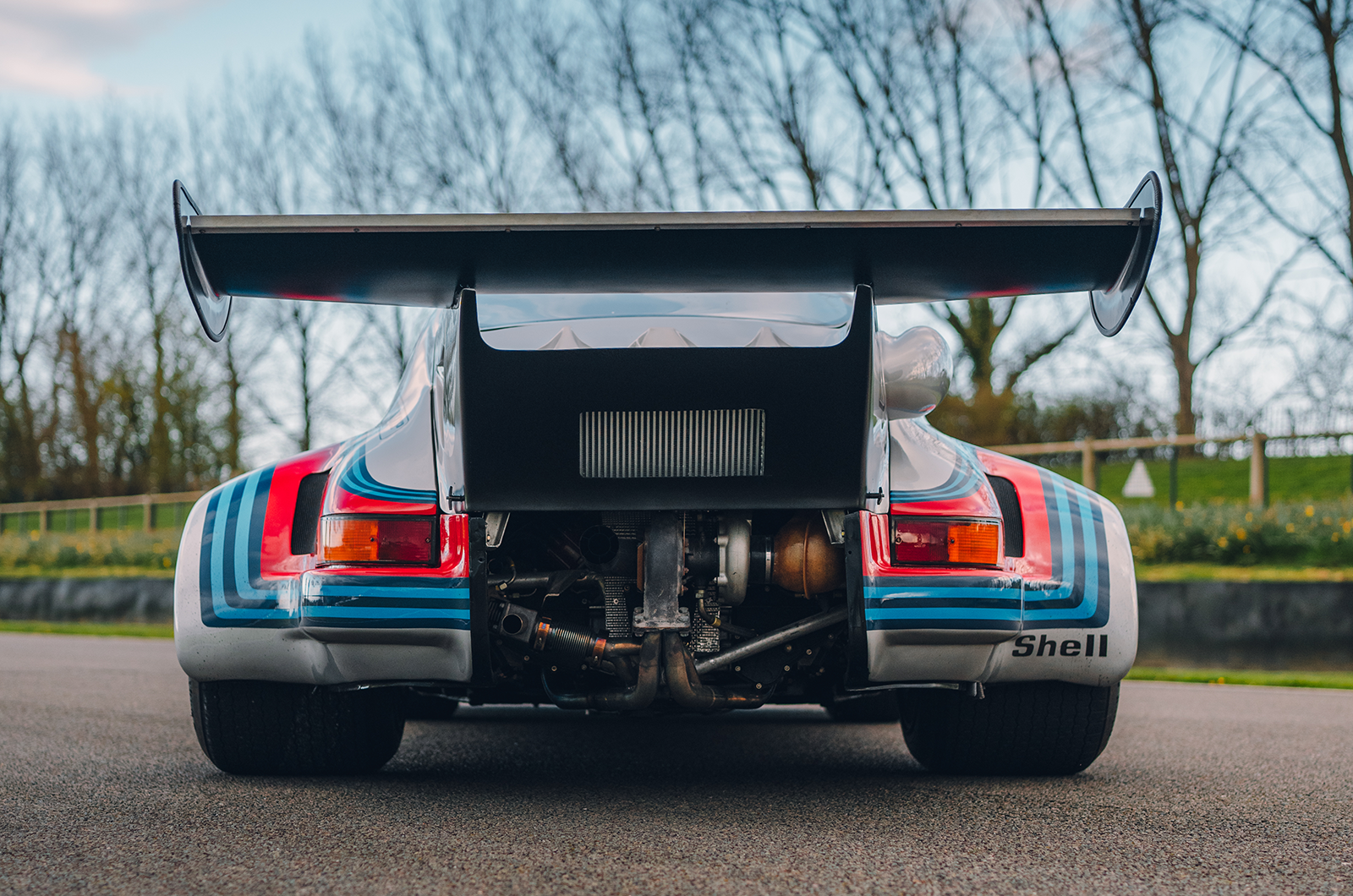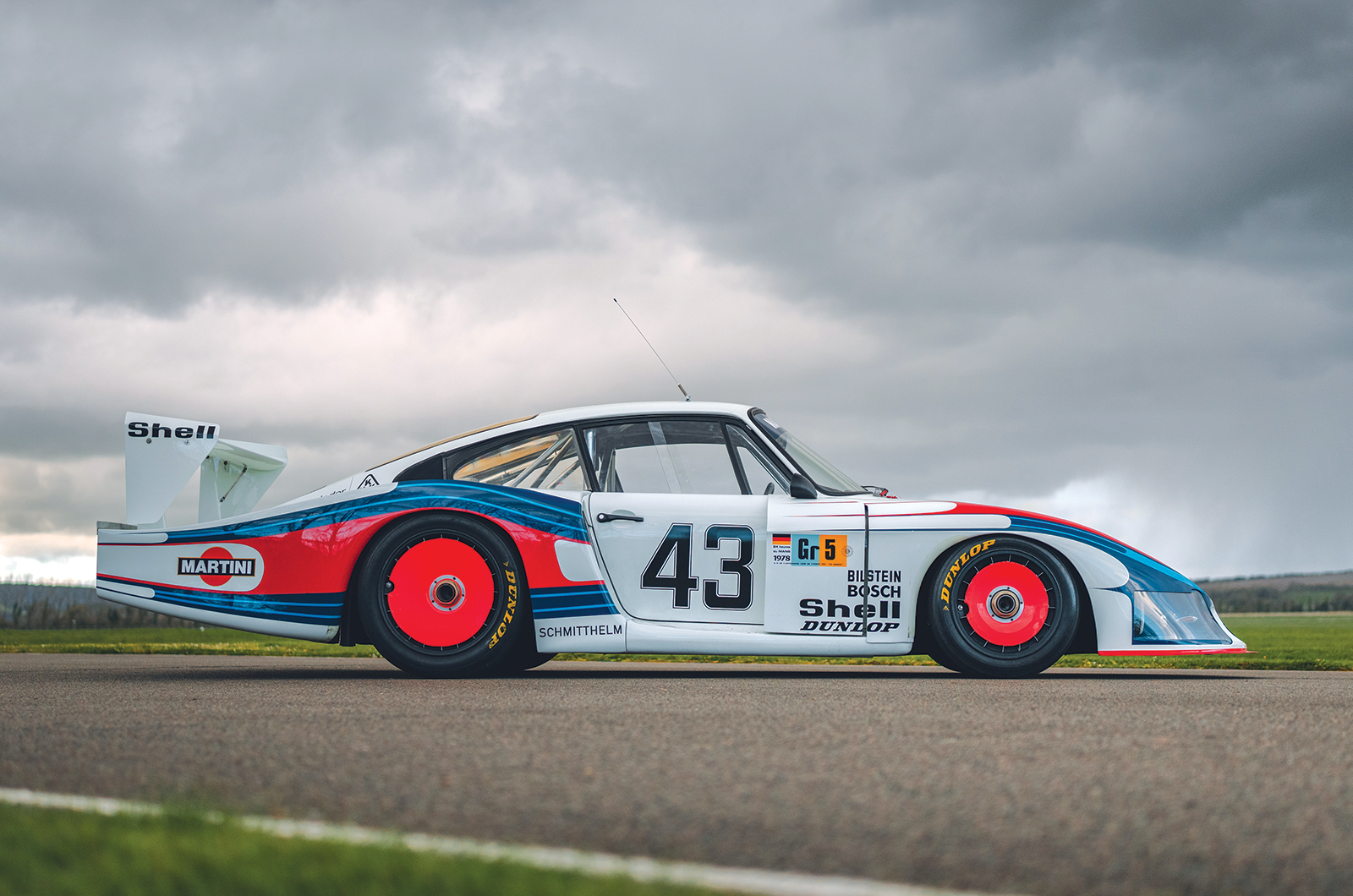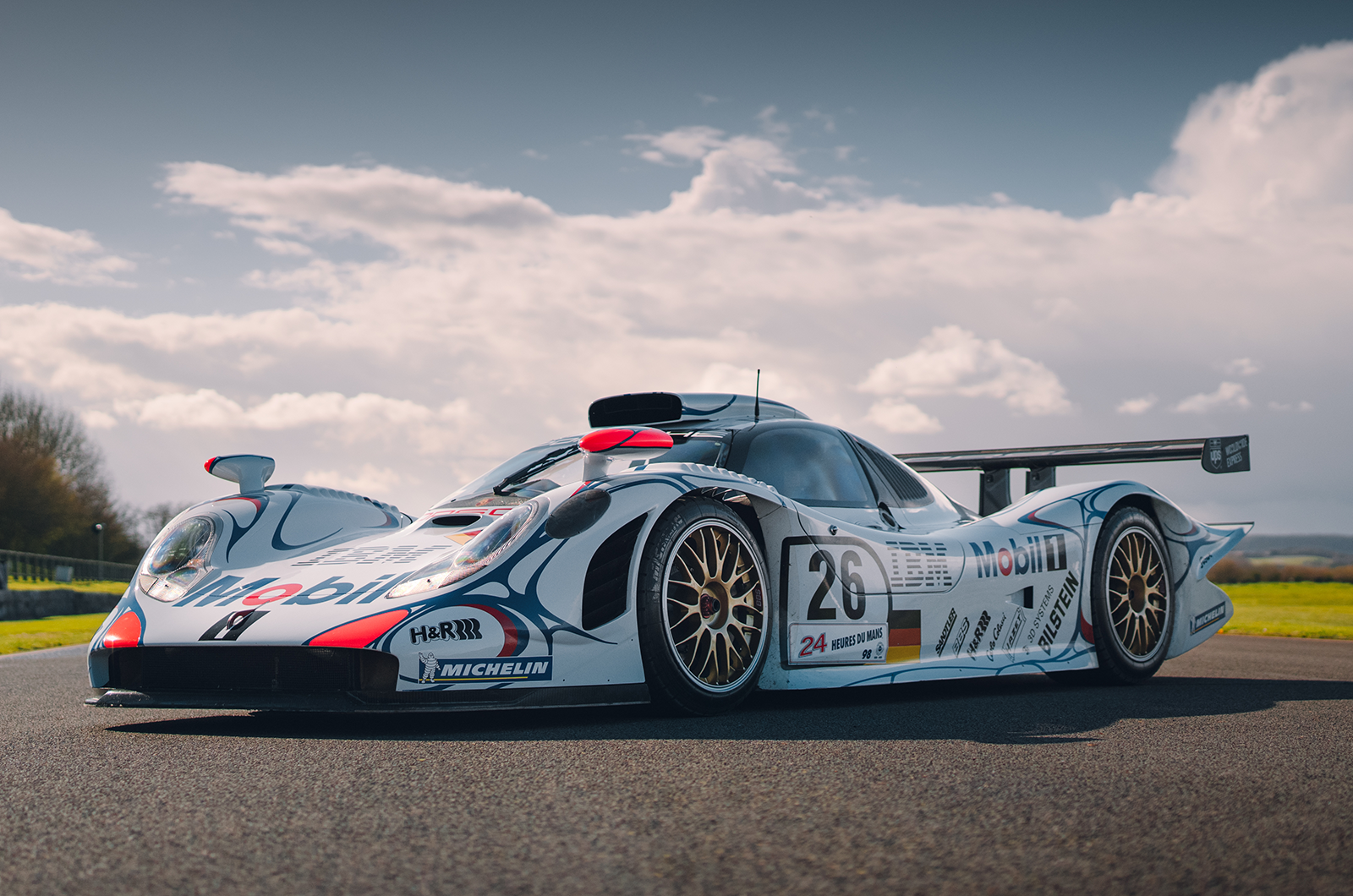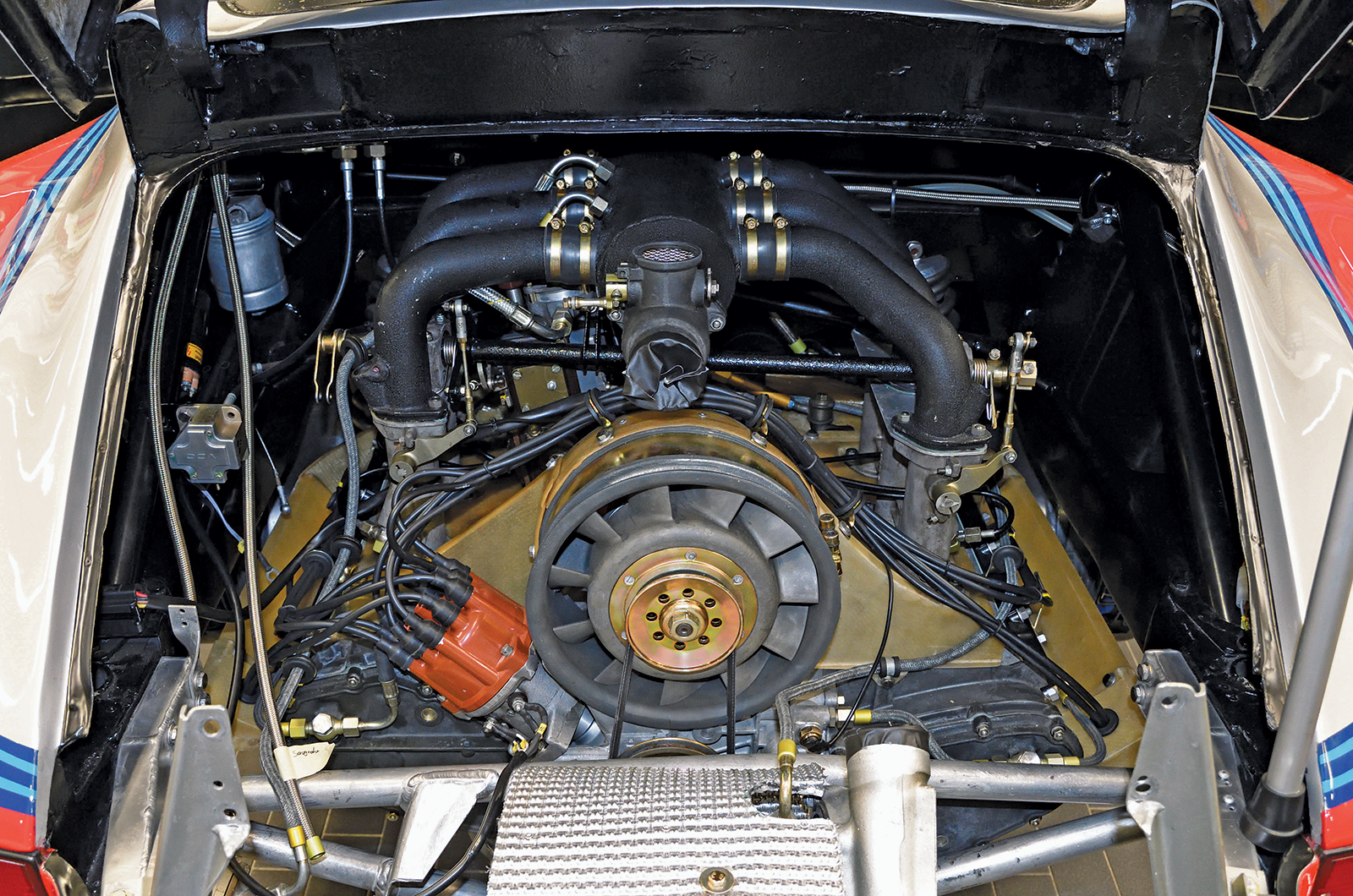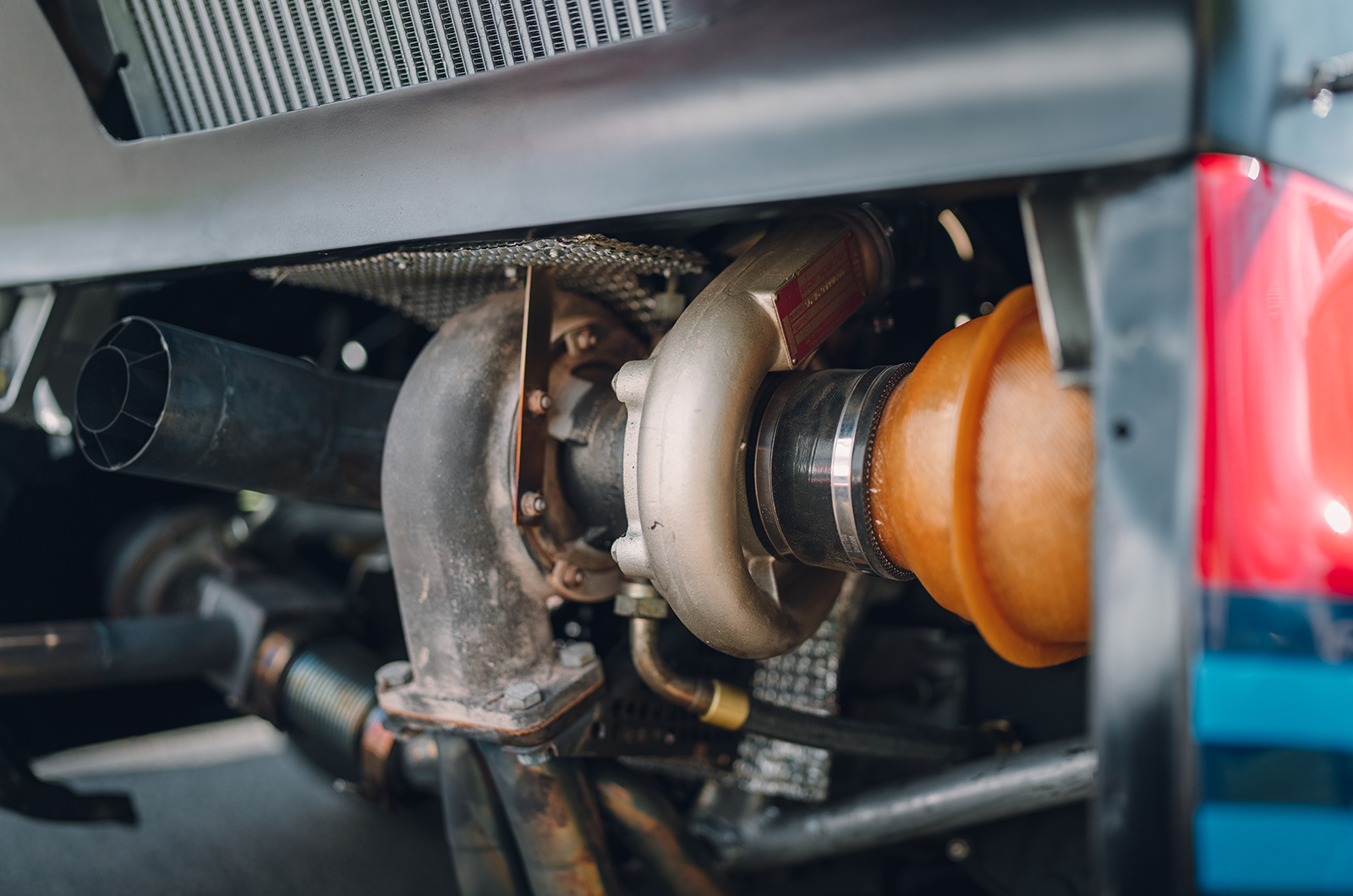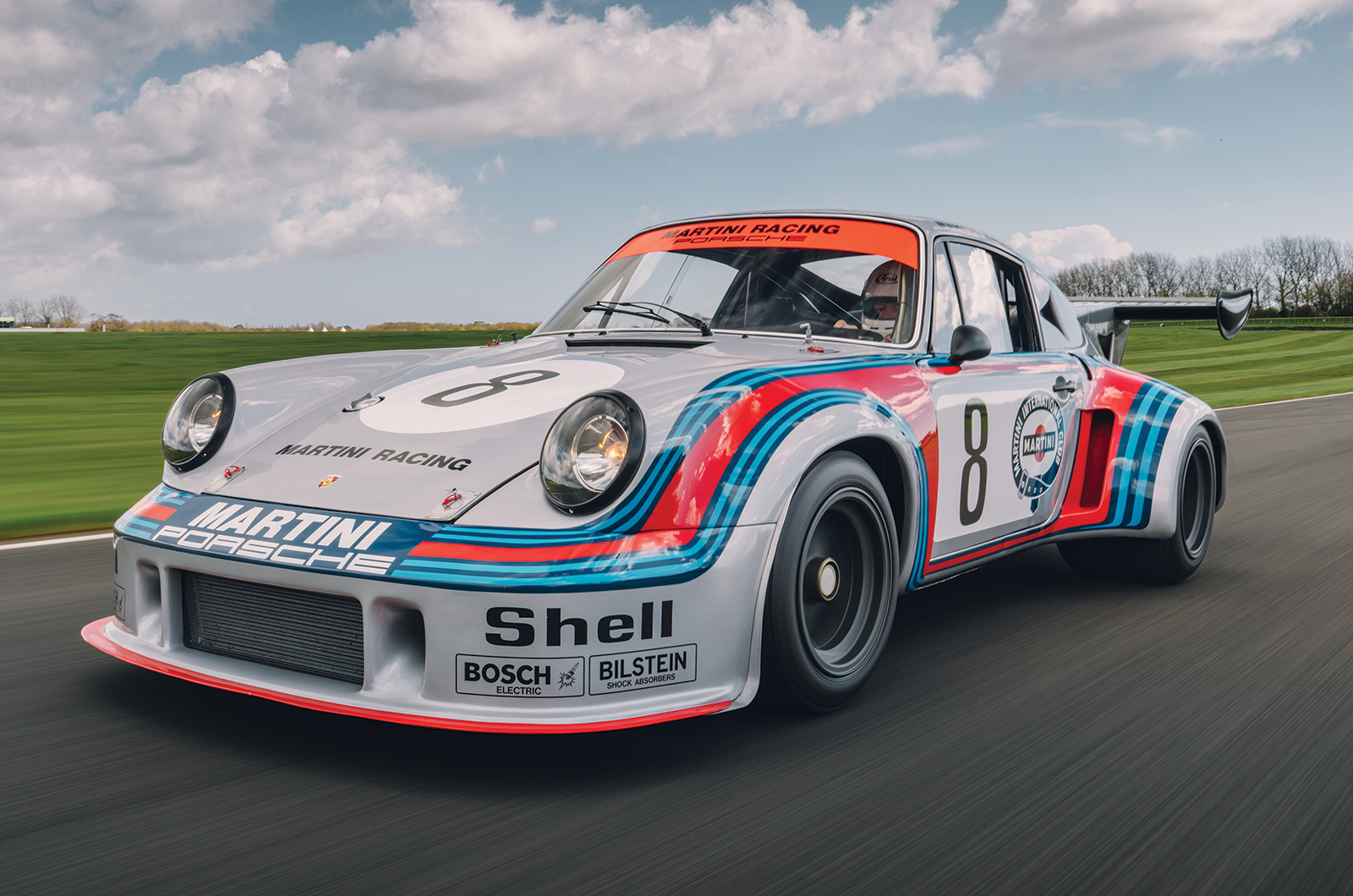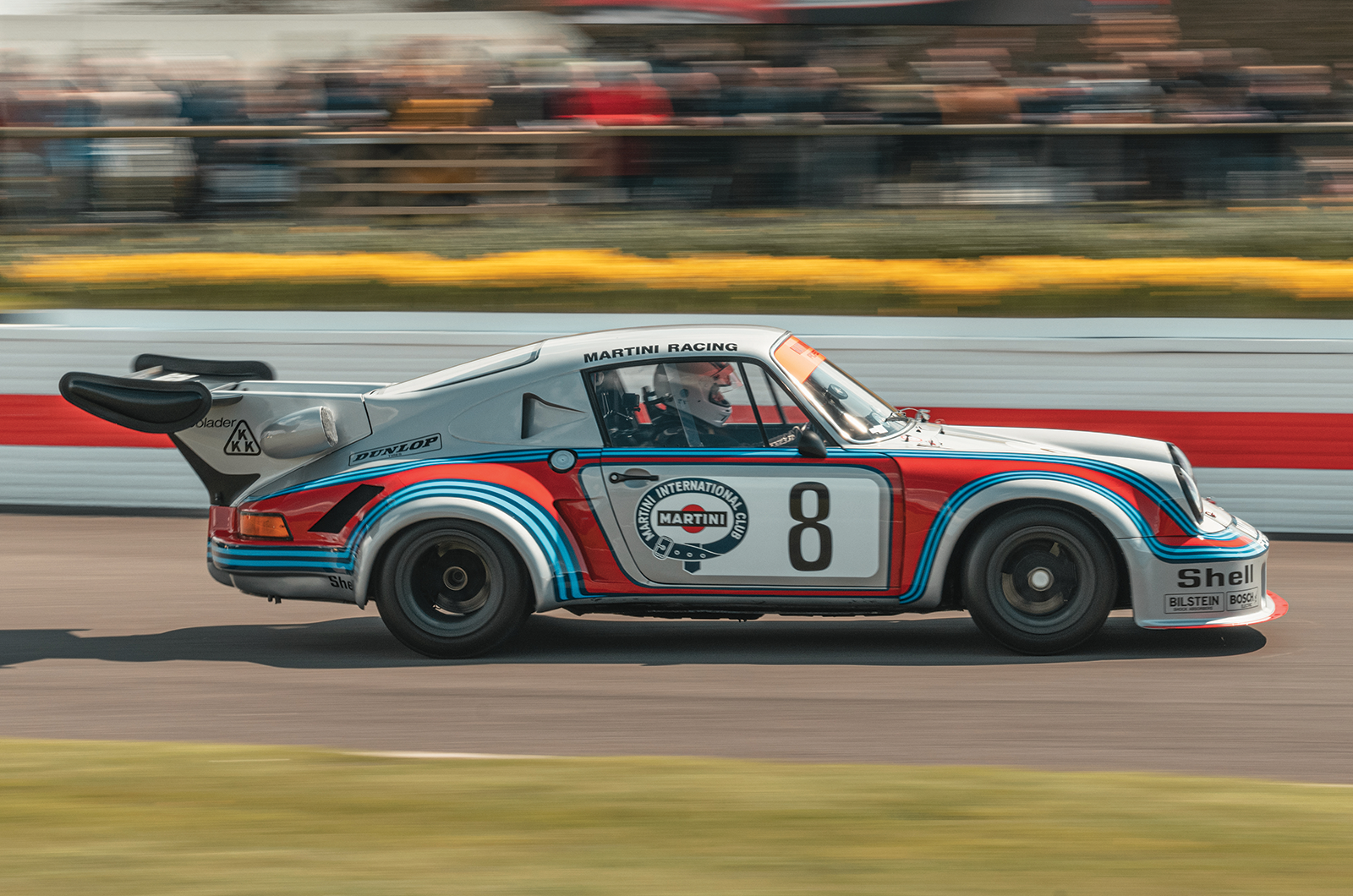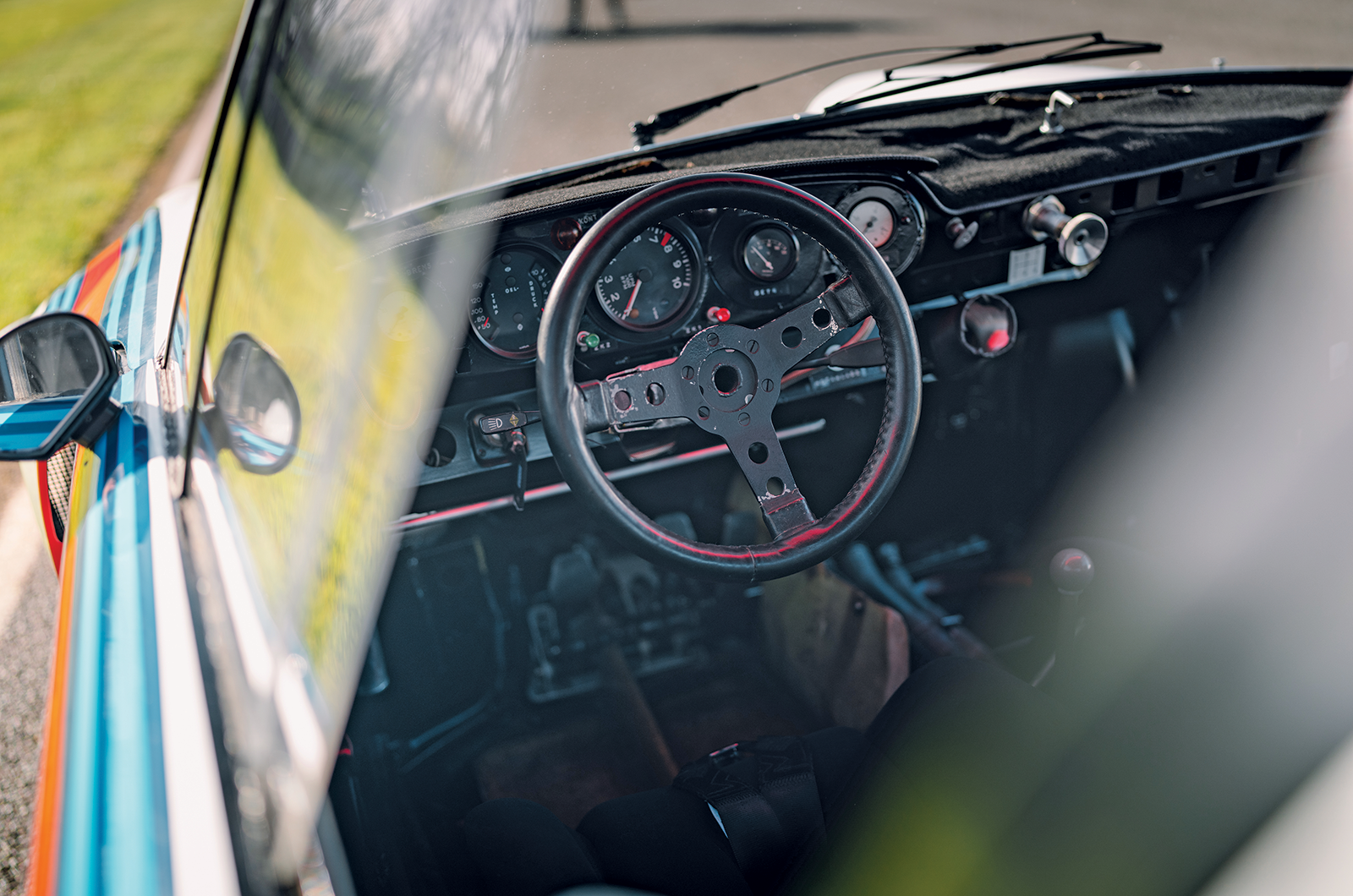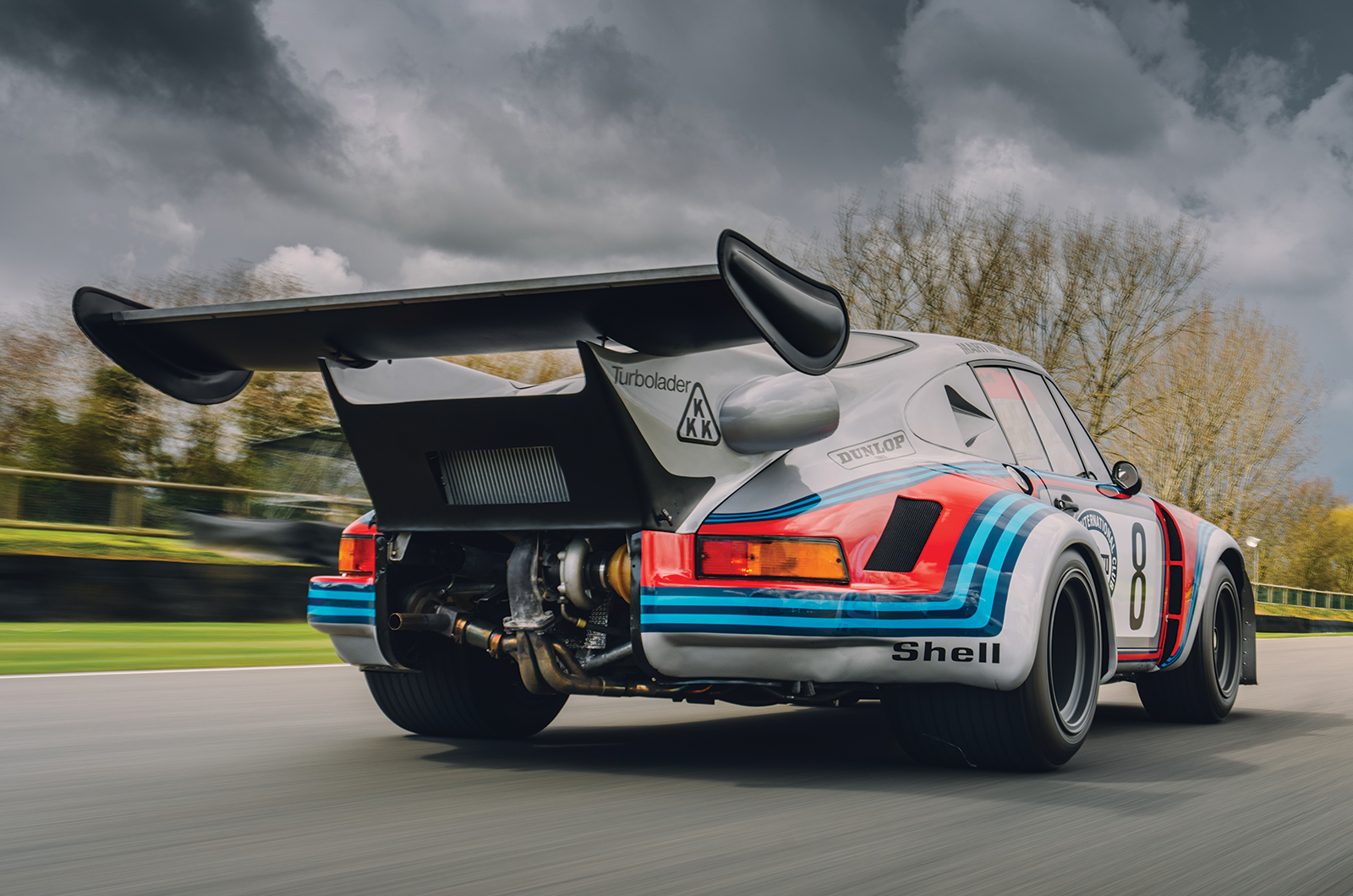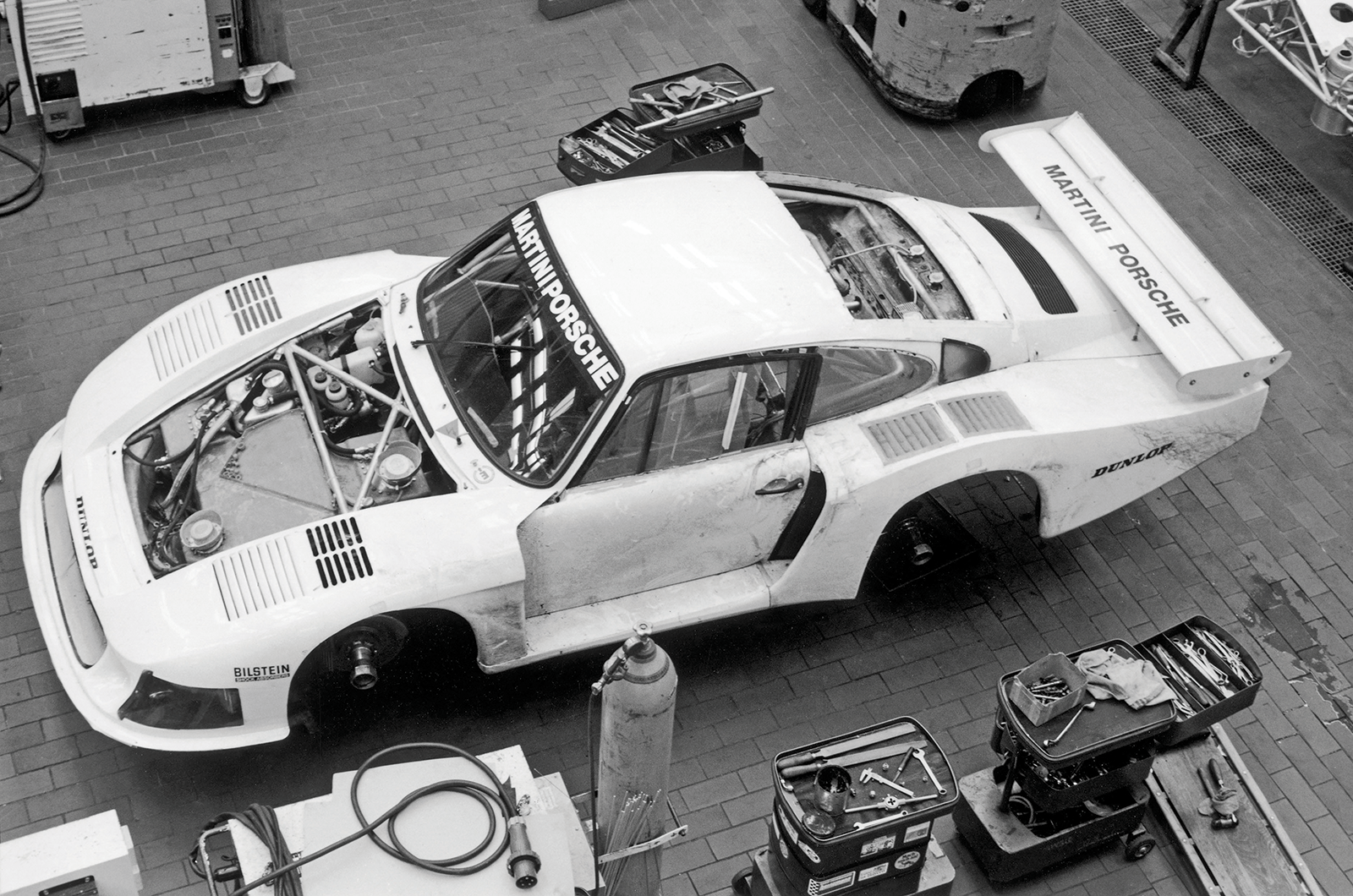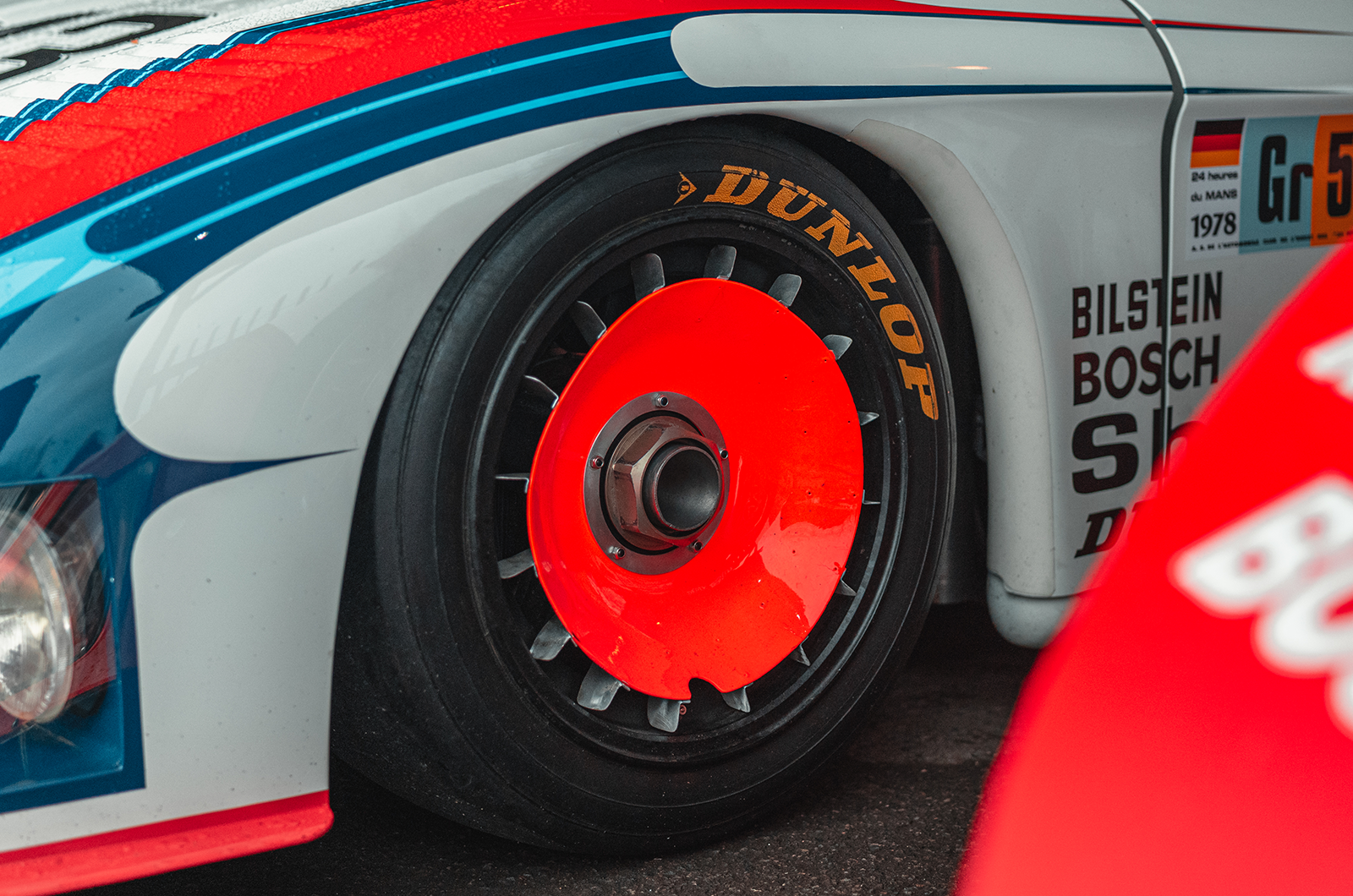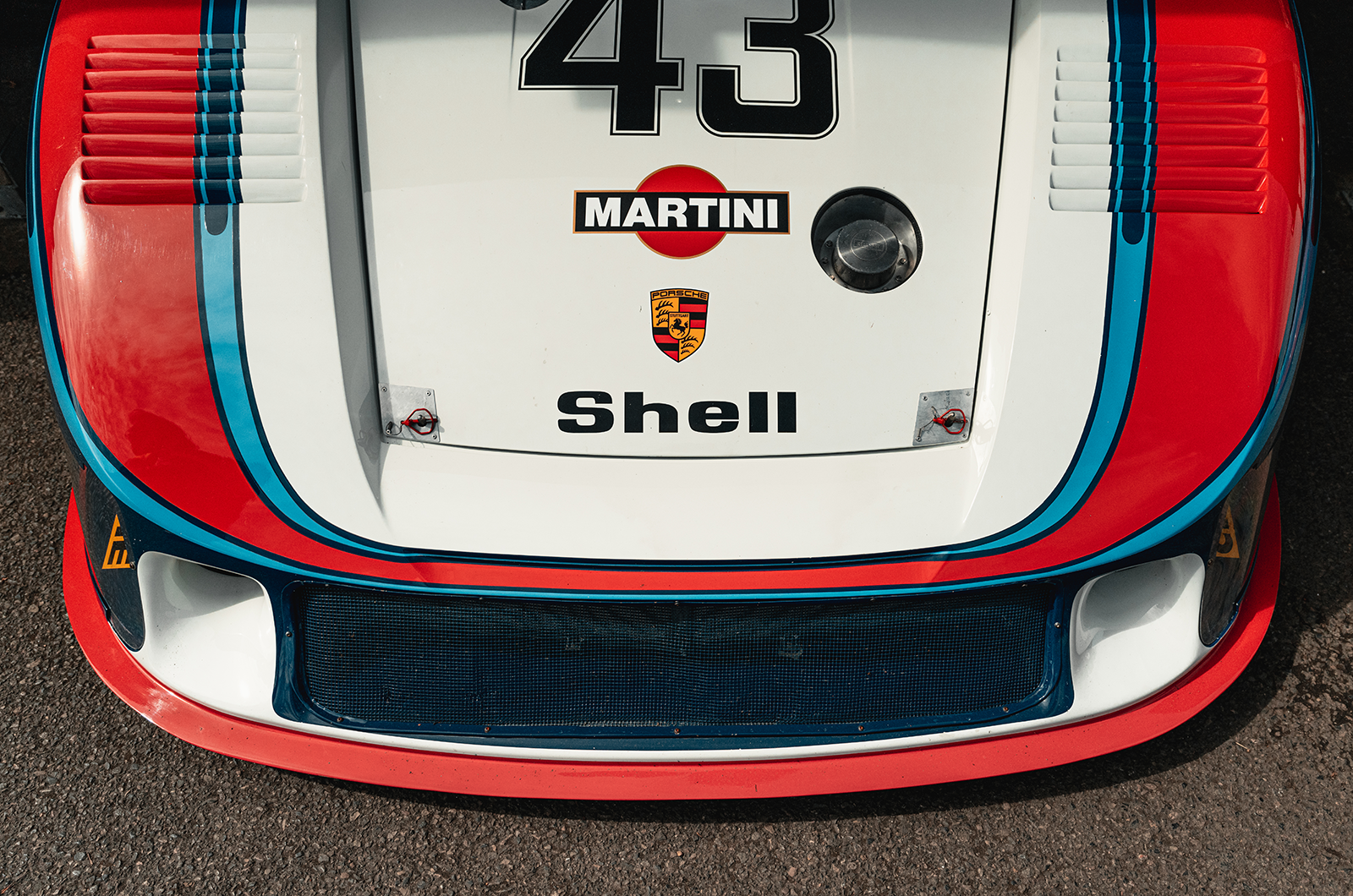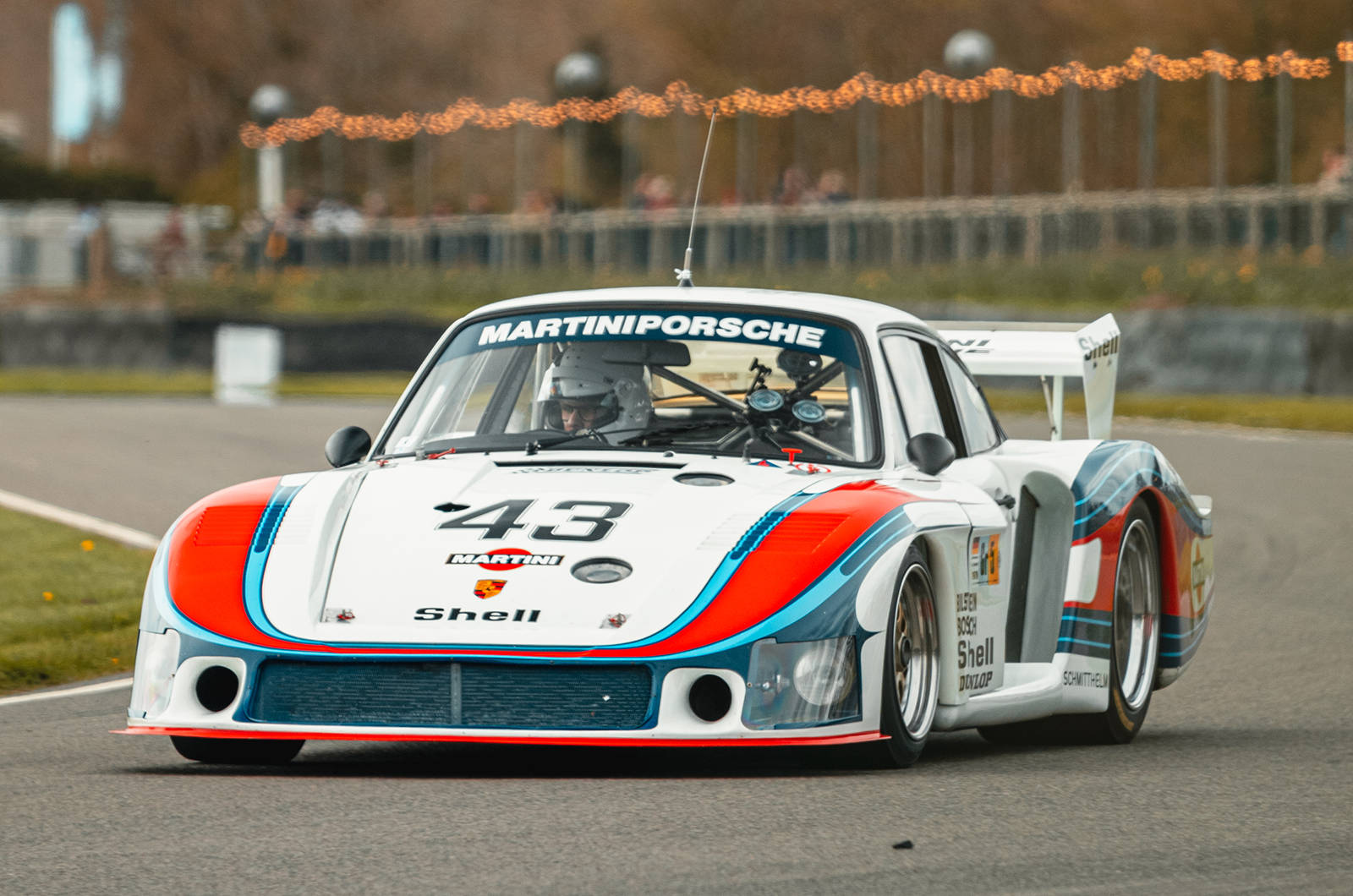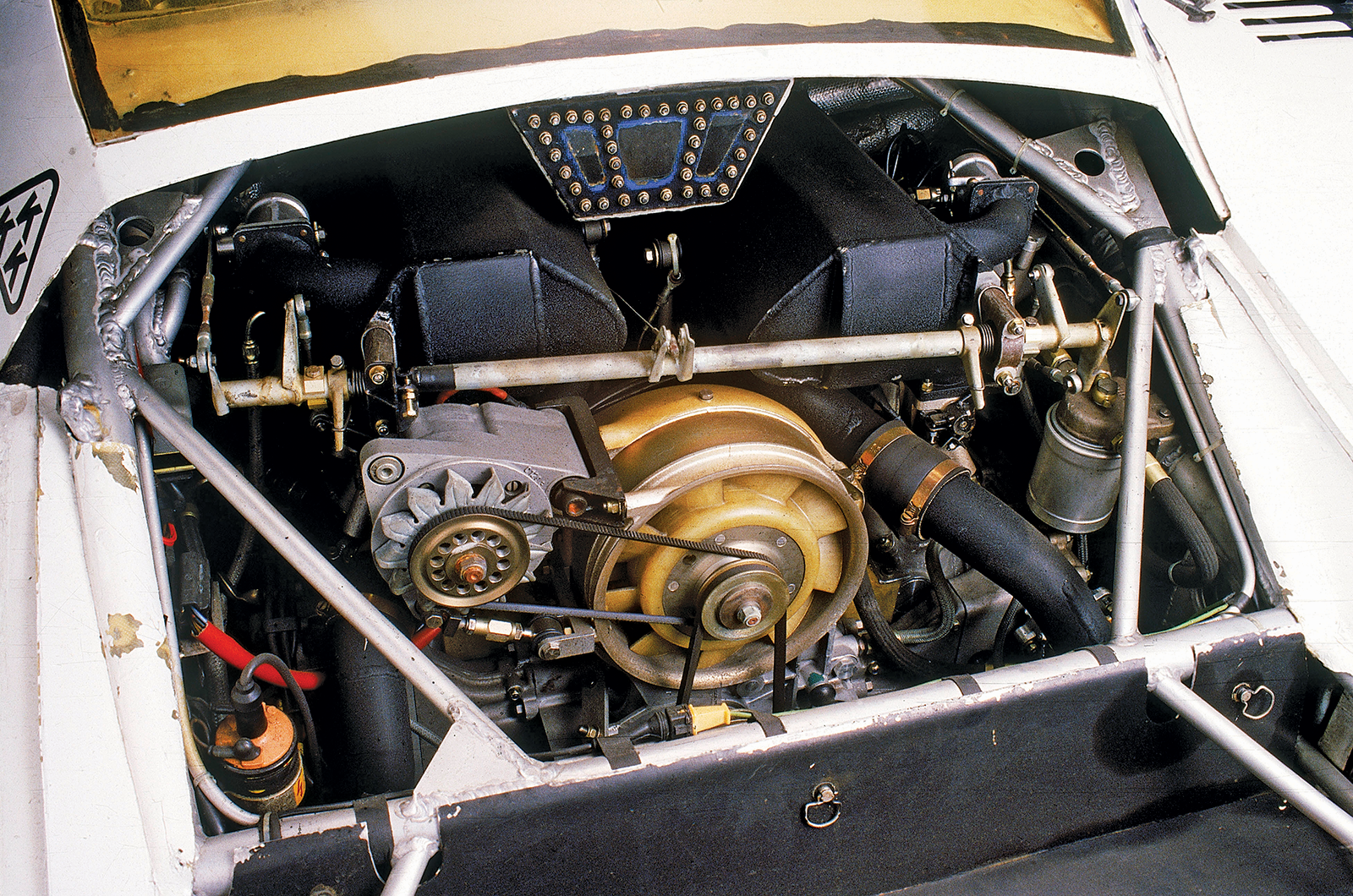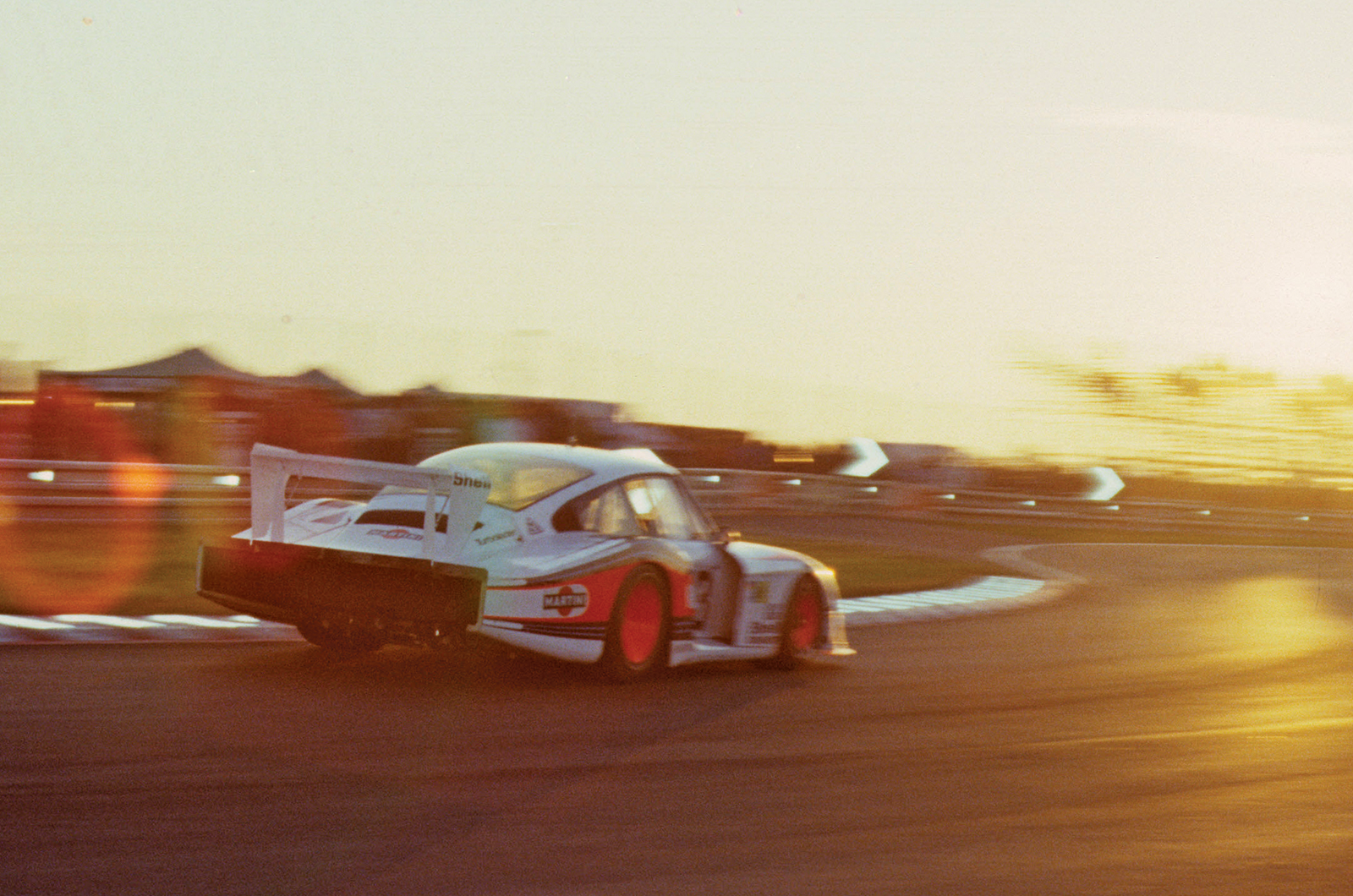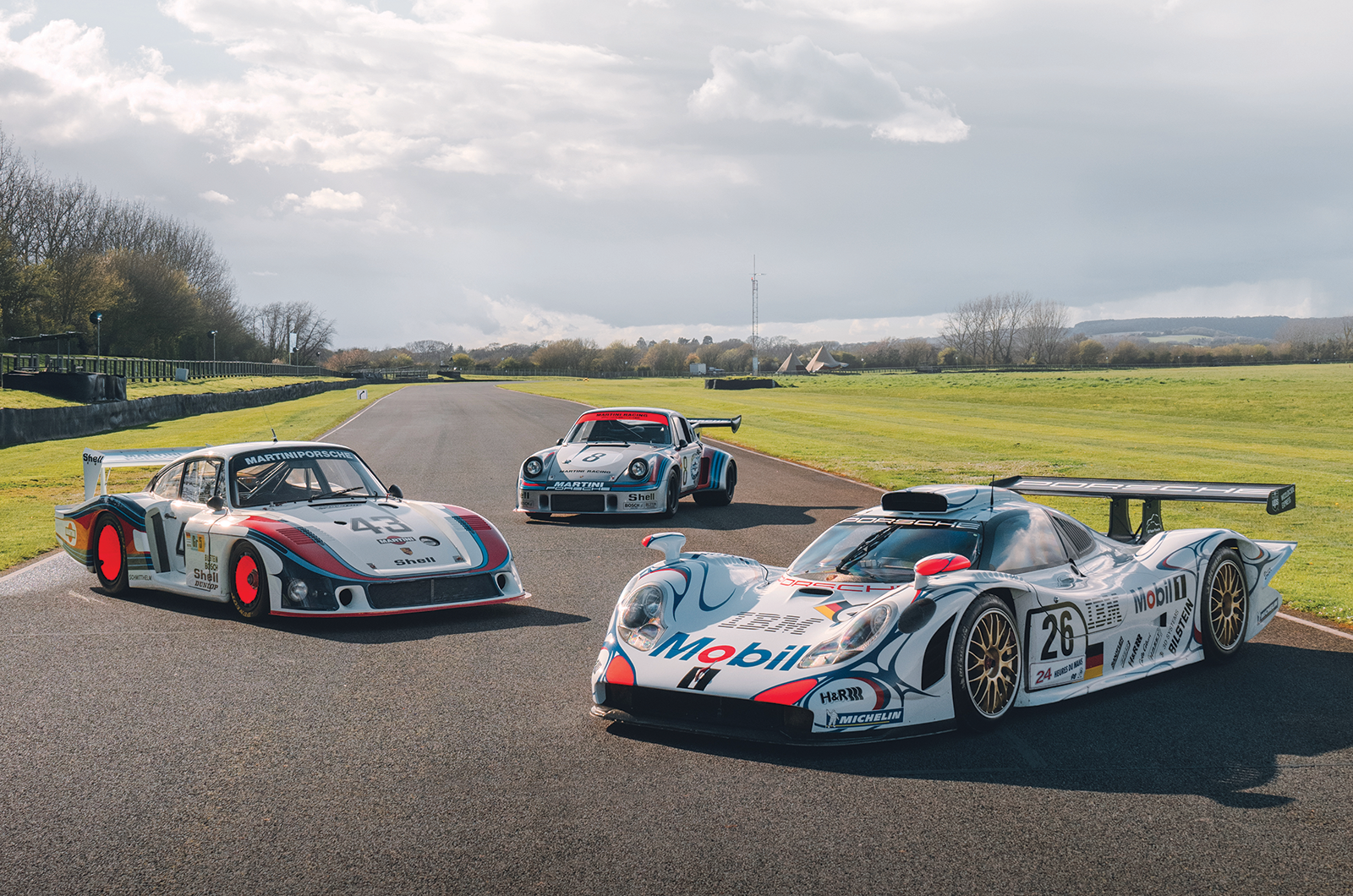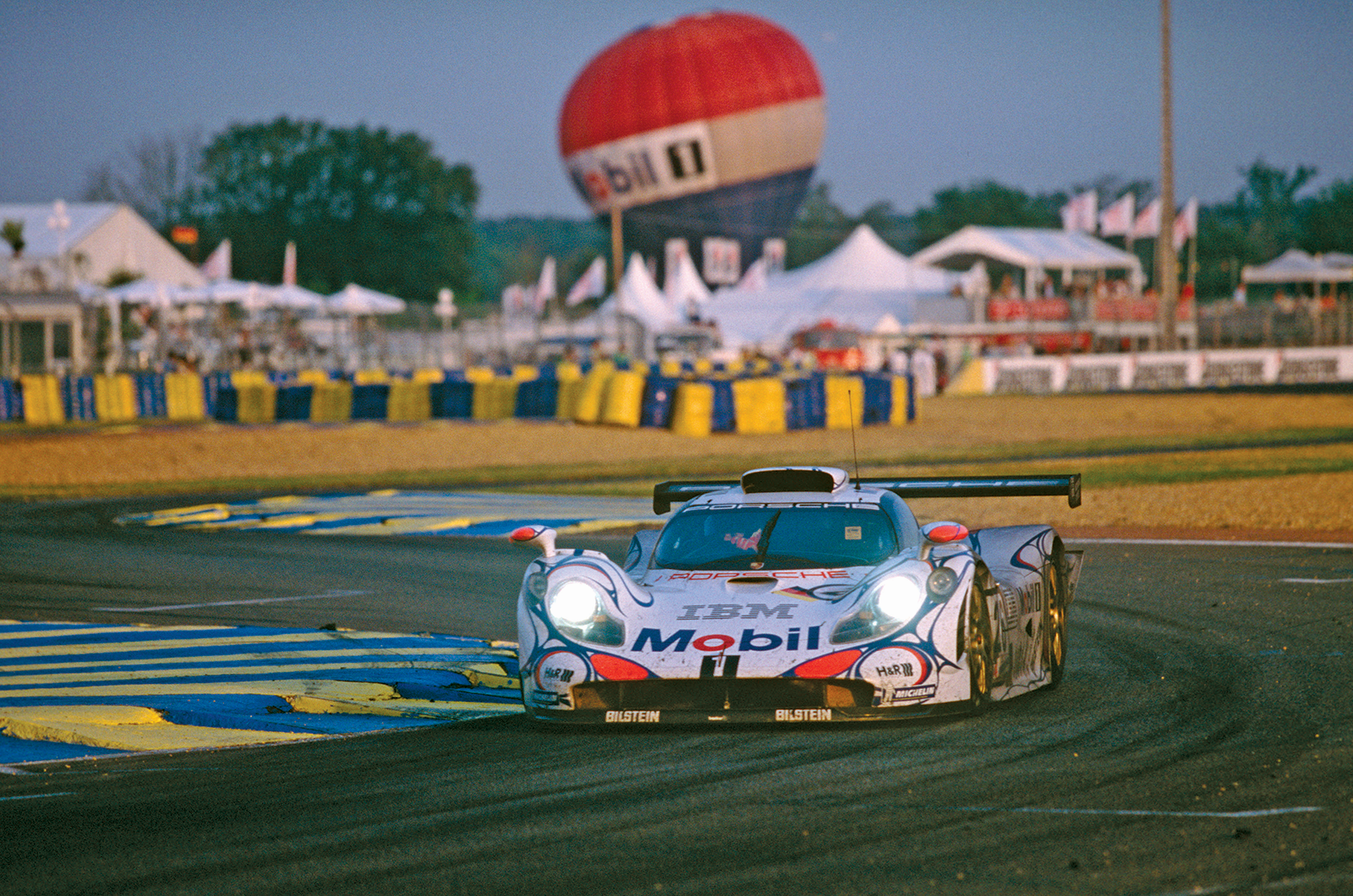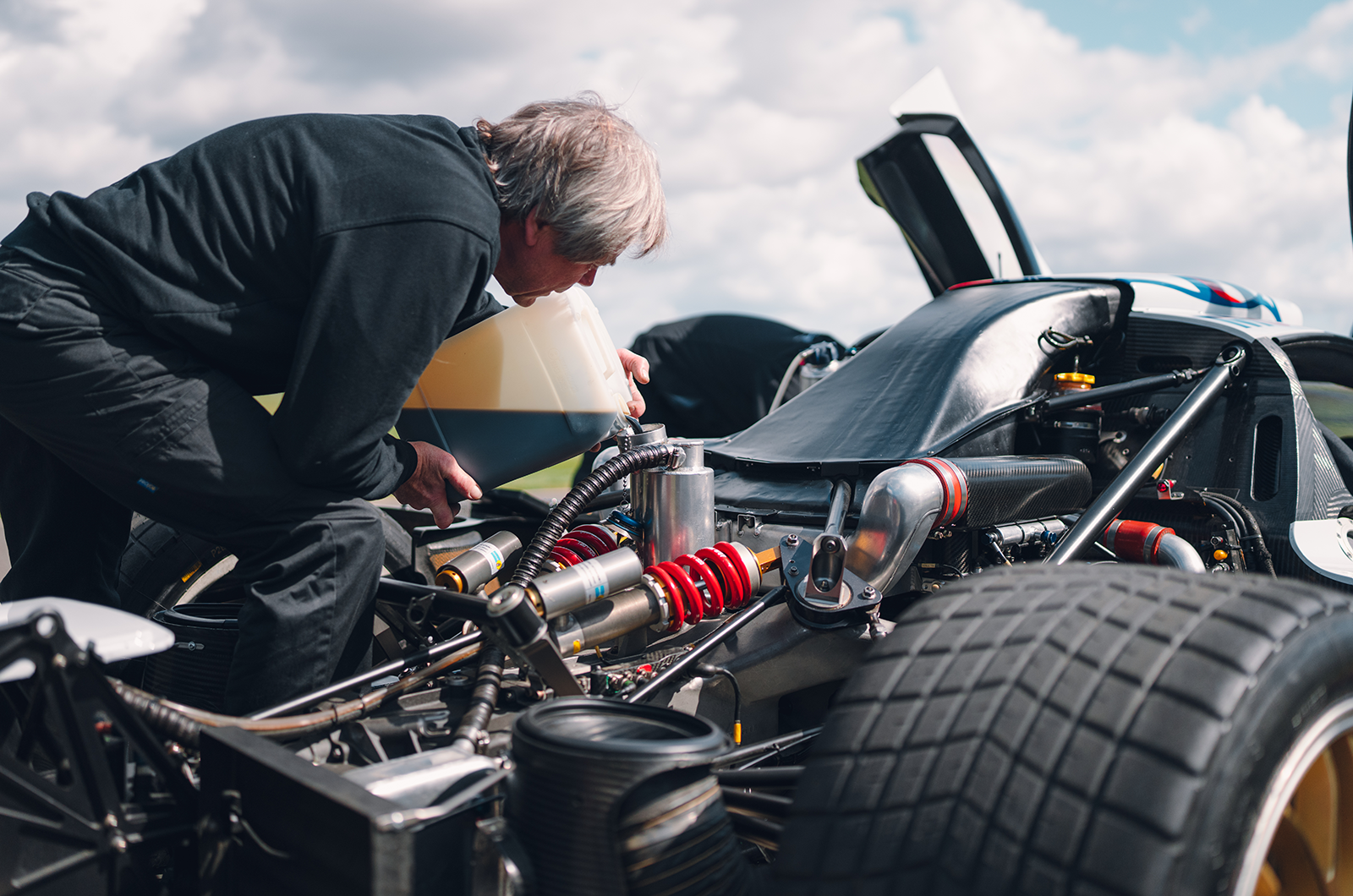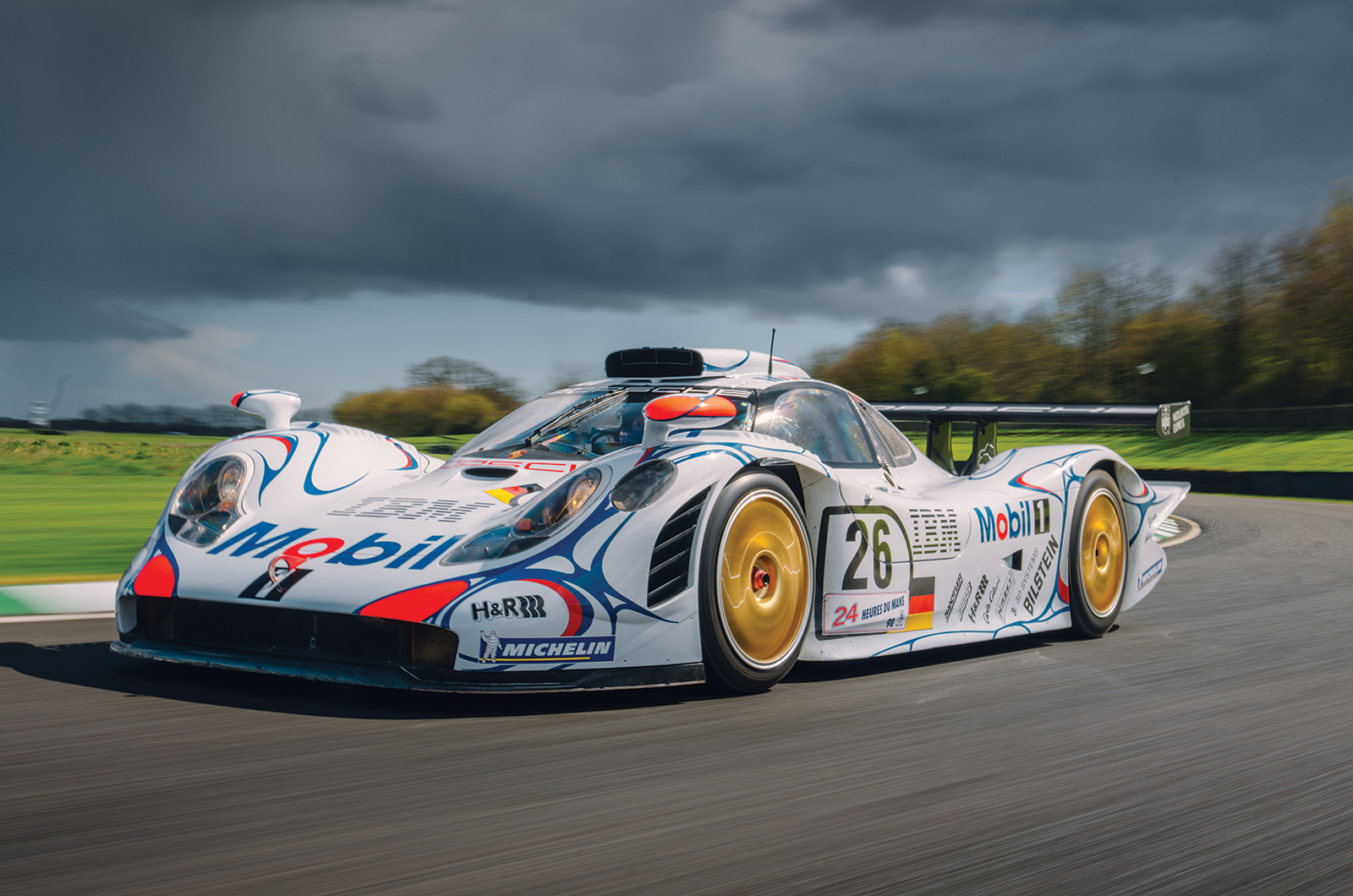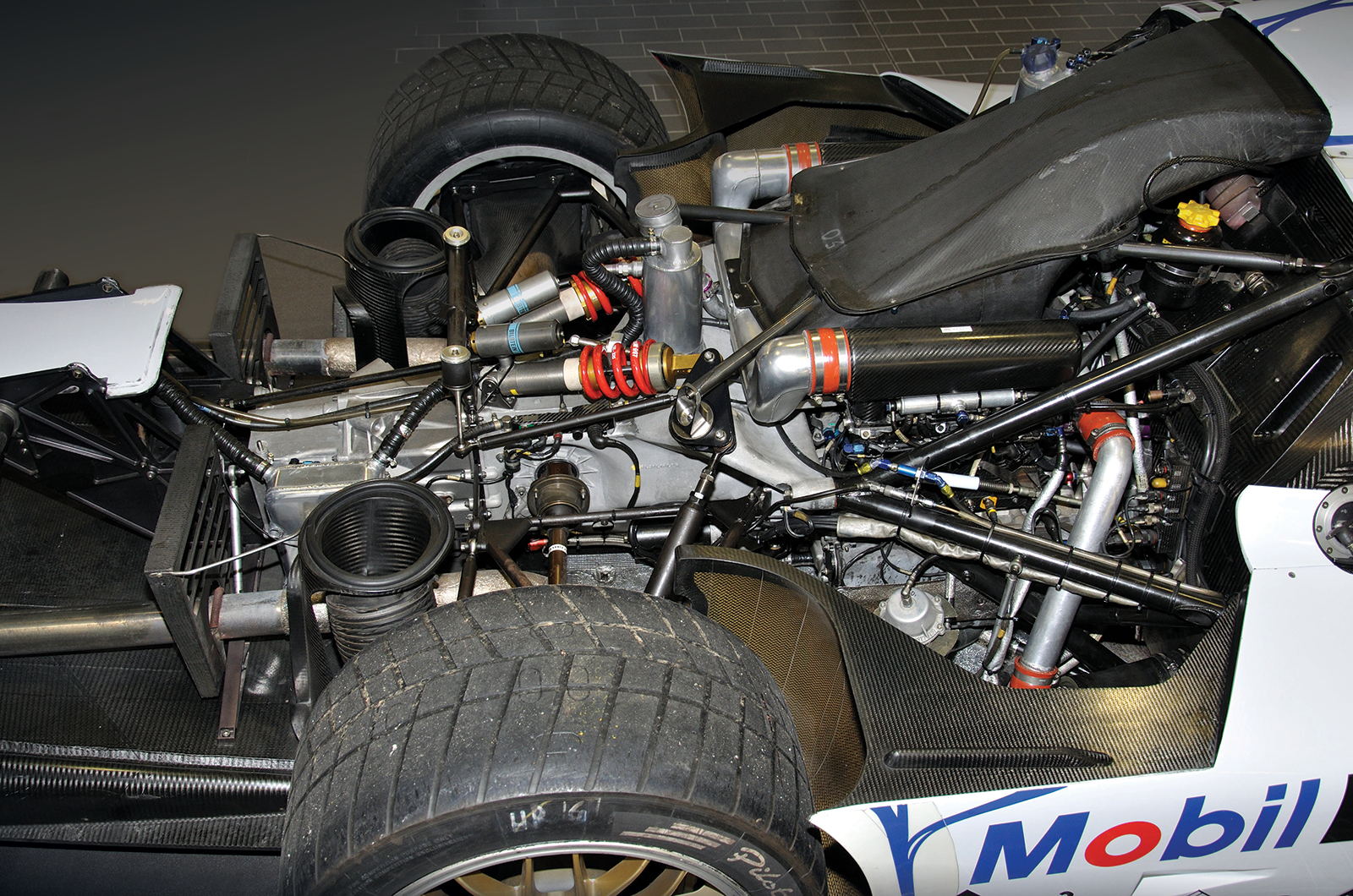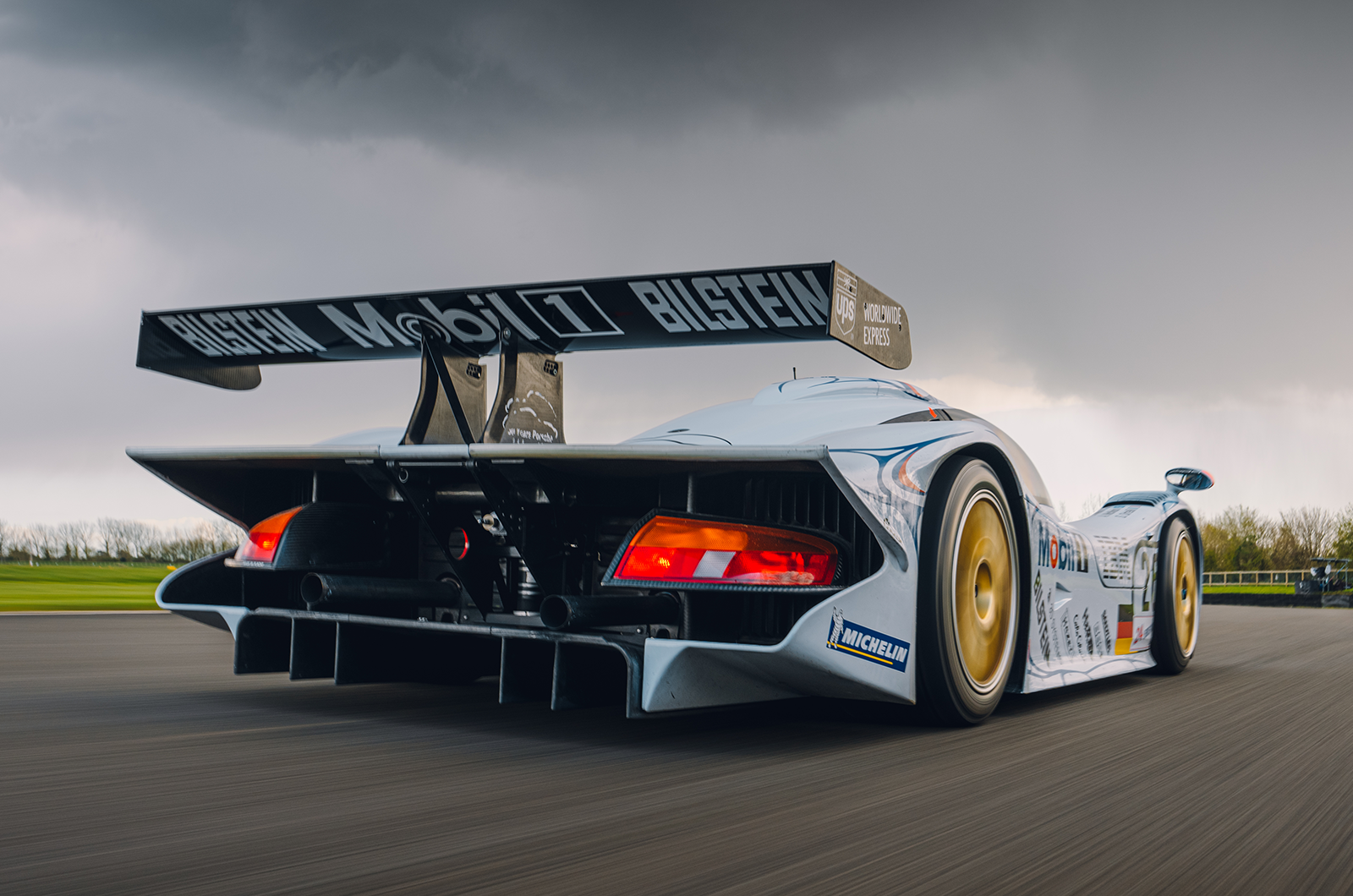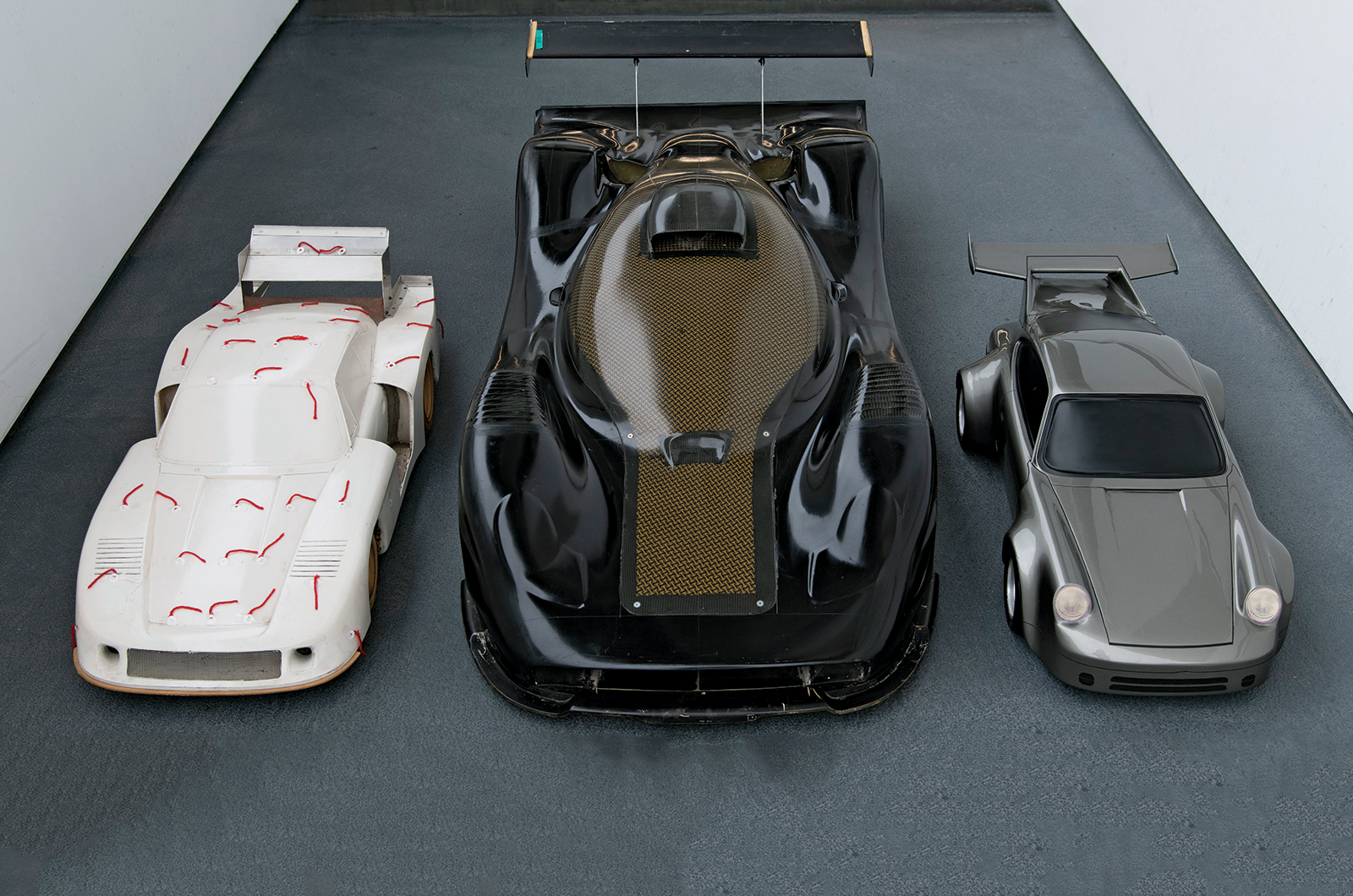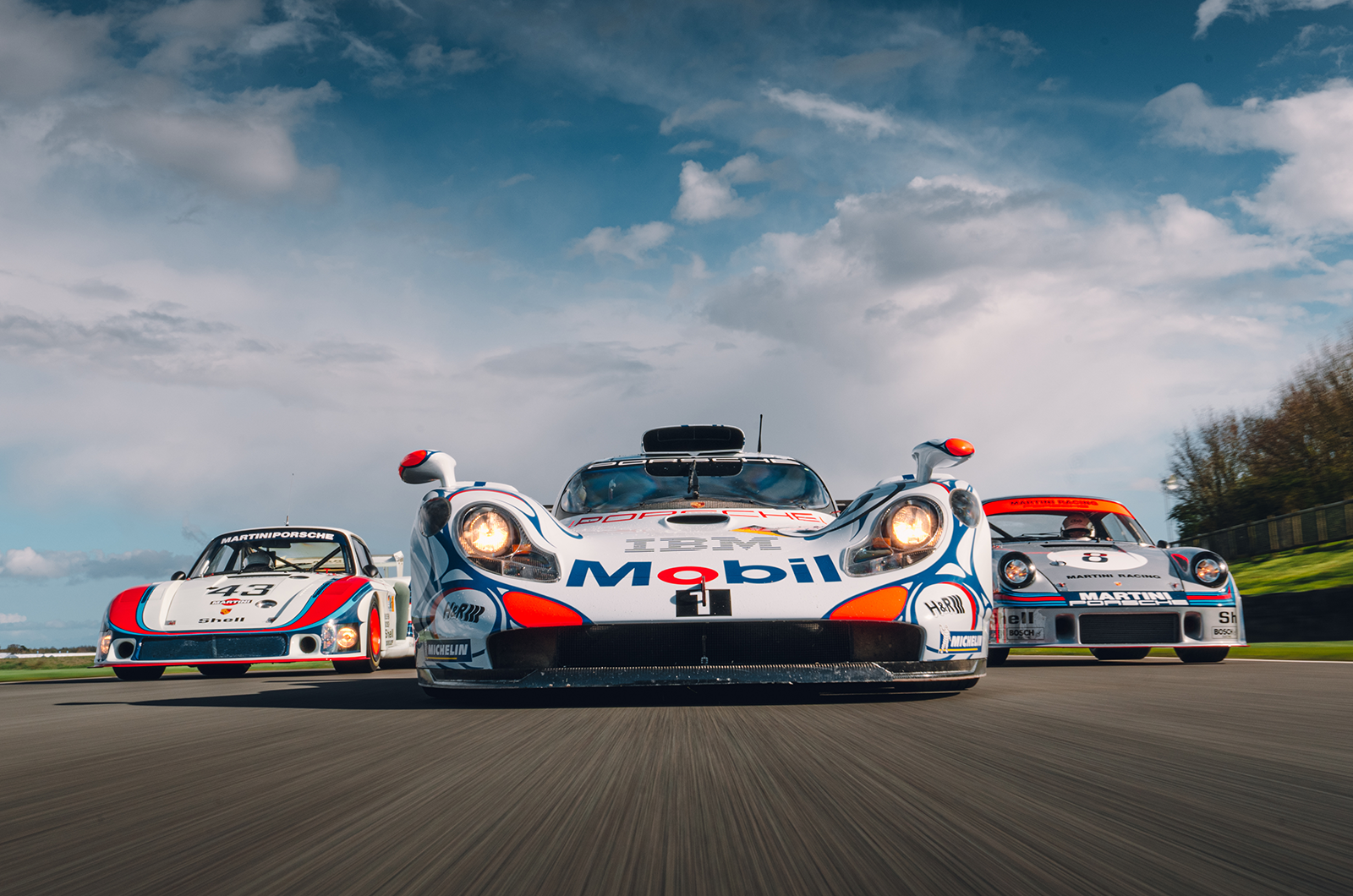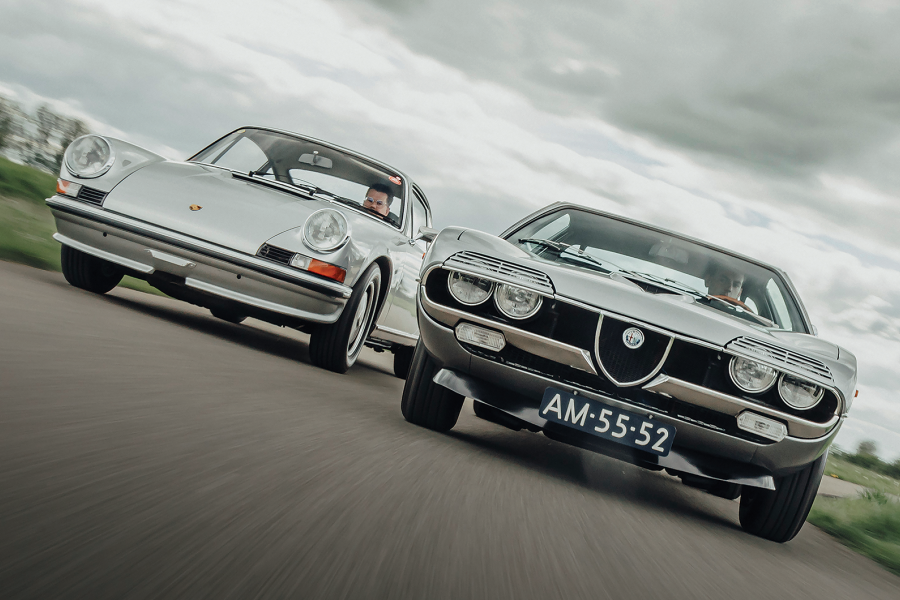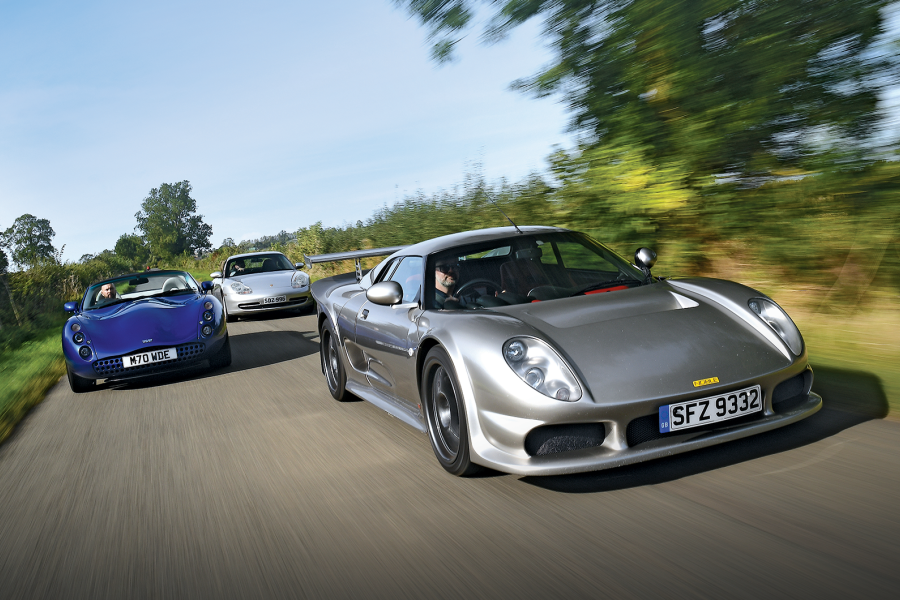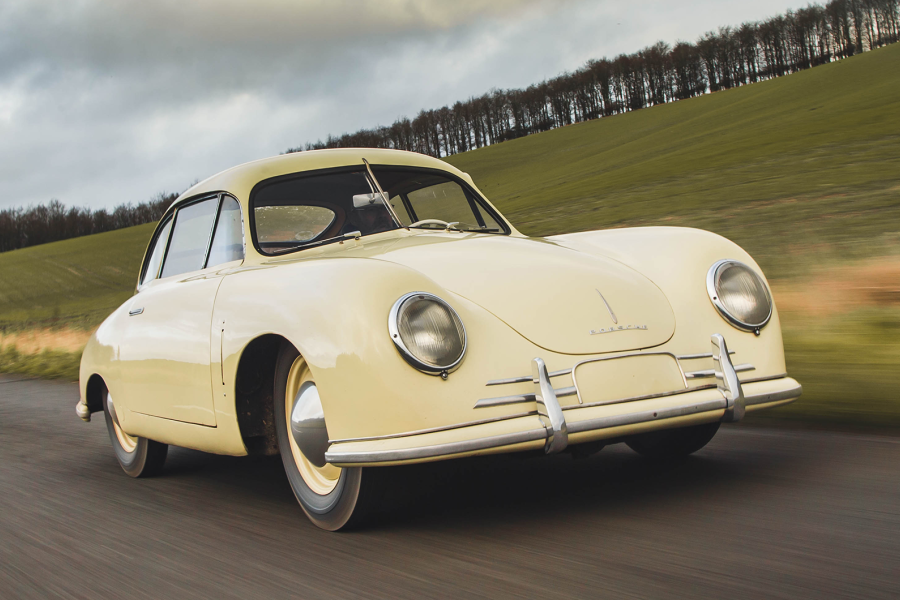Porsche’s engine maestro, Hans Mezger, enlarged the factory 935/77’s flat-six (by then featuring twin turbochargers) from 3 to 3.2 litres and introduced a water-cooled, twin-camshaft, four-valve cylinder head.
‘The expansive, Martini-liveried bodywork somehow manages to make “Moby Dick” look even more intimidating’
With a peak power output of nearly 850bhp in qualifying trim and a little over 750bhp in race tune, Moby Dick remains the most powerful 911 ever produced.
Is it any wonder that Porsche adopted the basic engine design for the 956?
As suggested by its slippery, streamlined bodywork, the car was primarily designed for the lengthy straights of Le Mans, but to get the 935/78 dialled in ahead of the iconic 24-hour event, the team entered the Silverstone Six Hours.
With Jacky Ickx and Jochen Mass at the helm, the car not only secured pole, fastest lap and overall victory, but also finished a scarcely believable seven laps ahead of the second-placed 935/77A at the flag.
The 230mph Porsche 911 935/78 feels surprisingly tractable
This momentum was then carried on to Le Mans, where in practice Moby Dick managed to outpace both the Renault-Alpine A442B prototype that ultimately won the race, and the two Porsche 936 prototypes that secured second and third places.
It was an achievement that would ultimately be the car’s highlight of the event, however, with massive fuel consumption and mechanical gremlins contributing to an eighth-place finish.
Yet on the Mulsanne it was timed at 227.5mph – 13mph quicker than the 936 prototype.
In person, the expansive, Martini-liveried bodywork somehow manages to make Moby Dick look even more intimidating than those mighty numbers suggest.
The Porsche 911 935/78’s stripped-out cockpit still has plenty in common with a G-series road car
Mercifully, once you’ve opened the correct door (unlike the RSR 2.1 turbo, it has its steering wheel on the right, placing the driver nearer the apex of the corners on most of Europe’s clockwise-running circuits), slid down into the felt-covered bucket seat and avoided putting your foot through the raised glassfibre floorpan (another of Singer’s innovations), the interior feels familiar.
Similar to the RSR turbo, the glasshouse is instantly recognisable; you grip a gorgeous, thin-rimmed wheel and there are five analogue dials in front of you, marked with old-school Dymo labels.
It’s only when you look left at the central boost knob, exposed gear linkage and floor-mounted anti-roll-bar adjuster that you remember you’re in something serious.
The Porsche 911 935/78’s innovative, rule-dodging tubular spaceframe wraps around its ridiculously potent flat-six engine
With only four gears and a top speed of nearly 230mph, the ratios are immensely tall.
Despite that, the 3.2-litre engine feels much more tractable than the 2.1-litre unit in the RSR.
Push the long-travel throttle to the floor and, once the boost gets on top of the ratio, a catapult-like thrust shoves you down the track and into the next braking zone.
Unlike in the RSR, however, there is no sense of being strapped to a runaway train, with the 935 feeling stable on the way into, through and out of high-speed corners.
Porsche mechanics gave the 935 its nickname, Moby Dick
This is a racer that feels better and more communicative the faster you go, with a chassis balance that is more reminiscent of a modern-day Radical than a 911-based production car.
It’s a completely transparent driving device, a machine that was more than 20 secs quicker around the Circuit de la Sarthe than the 2.1 – and one that encourages you to brake later and pick up the throttle earlier.
Without realising it, you’re soon trying to piece together a half-decent lap in a one-of-one museum piece, letting the car move around underneath you on the exit of Madgwick as you take full advantage of the 700bhp-plus pulsating through the rear axle.
It must have felt sensational at Le Mans.
Three Porsche 911 turbo racers on an empty Goodwood circuit
The 935/78’s otherworldly pace led customer teams to petition Porsche to retire the car at the end of the season, a request it duly respected.
But it makes you wonder. When the engineers pushed Moby Dick into storage, did they pause to contemplate where the development of the turbocharged 911 racer would end up?
Just four years had separated the RSR turbo and 935/78. What could the same team achieve in 20 years?
Fortunately for us, we don’t have to speculate because at the other end of the paddock awaits the ultimate iteration, the 1998 911 GT1.
Stéphane Ortelli powers the winning Porsche 911 GT1 through Virage Ford at Le Mans in 1998
Its existence came about through the revival of international sports-car racing in the mid-1990s via the BPR Global GT Series, which later morphed into the FIA GT Championship.
Having not secured a win in the top category since 1994 with the Dauer 962, team boss Herbert Ampferer recognised that Porsche needed to develop a radical GT1 competitor if it was to compete with the might of the Toyota and Mercedes-Benz factory teams.
After draft designs initiated in 1995 and subsequent early incarnations over the next couple of years, the 1998 911 GT1 adopted an entirely new strategy.
Not much of the Porsche 911 remains bar the name in the outrageous GT1
Employing a clean-sheet design, Porsche adeptly exploited the rulebook once again, engaging in an effective reverse-engineering process to homologate a road car derived from its racer, with only one unit required.
This innovative approach empowered the engineering team to pioneer Porsche’s inaugural carbonfibre monocoque chassis, introduce carbon-ceramic brake discs, and craft an aerodynamic carbonfibre body using computer-aided design.
At its centre sat a fully water-cooled (for the first time on a 911), 3.2-litre twin-turbocharged motor, based on the engine first seen in the 962.
Despite the enormous engineering effort put into the GT1, it was not the fastest car on the Le Mans grid in 1998.
‘Despite being 200bhp down on Moby Dick, the Porsche 911 GT1 feels even more animalistic as its wheels scrabble for traction’
Mercedes-Benz secured first and third positions in qualifying, with its CLK-LMs split by a Toyota GT-One.
Porsche, meanwhile, had to settle for fourth and fifth, with its GT1s almost three seconds off the fastest lap of the polesitting Benz.
To finish first, however, first you must finish, and over the course of the following 24 hours both CLK-LMs retired with water-pump failure and the GT-One with a broken gearbox.
This turn of events paved the way for the two Porsche entries to cross the finish line in graceful formation, securing a celebrated 1-2, a triumph that marked both Stuttgart’s 16th Le Mans victory and the GT1’s swansong.
The Porsche 911 GT1 has a fully water-cooled flat-six that foretold the forthcoming 996-generation road car
It never returned to compete at Le Mans after the discontinuation of the GT1 class.
Nevertheless, it had fulfilled its purpose, landing an outright win for a ‘production’ car in the same year customers were taking delivery of the first fully water-cooled roadgoing 911 model, the 996.
Not that the two cars shared a whole lot in common, mind.
When climbing into the GT1, you might just notice that it features 996 doorhandles, but as the panel swings up and forward to reveal the all-carbonfibre chassis, any notion that this is a road car immediately dissipates.
The Porsche 911 GT1’s snug, complex driver’s compartment feels a world away from the bare-bones 935
This is a full-on prototype racer with a cramped cockpit, poor vision and a sequential gearbox on the right that, when combined with the impossibly low roof, must have made quick pitstops for the three drivers a real challenge.
The cockpit is a curious mix of old and new, with the bare Momo steering wheel at odds with the thoroughly modern carbonfibre sill.
During the belting-in process, this unusual juxtaposition serves as a handy reminder that this is not a modern Le Mans Hypercar (LMH) because, despite its futuristic exterior aesthetic, once you’re on the move there is no getting around the fact that this is an analogue racing machine that deserves your respect.
Despite being more than 200bhp down on Moby Dick, the GT1 somehow feels even more animalistic, its rear tyres scrabbling for traction with every flex of your right foot.
The Porsche 911 GT1 was a clean-sheet design from Stuttgart
And, while there’s a sequential transmission to help keep the peaky engine on the boil, it’s nothing like a modern ’box, requiring the use of the clutch on up and downshifts.
This is not a problem in theory, but the grabby brakes make it tricky to heel-and-toe; the sense of satisfaction when left foot and right hand successfully match revs to wheel speed is wonderful, but get it wrong and it locks the rear wheels faster than you can say achtung!
The rest of the package, though, is nothing short of astonishing.
The nose responds to the smallest steering input, you can feel real downforce being produced by the wings and underbody (the mid-engined layout allowed for a huge rear diffuser), and the punch in the kidneys from 4-6500rpm is utterly addictive.
Porsche’s wind-tunnel models show the evolution of the shape, from bewinged 911 to slippery prototype
It eggs you into taking advantage of its colossal limits, even if you know in your heart you’ll never reach them.
Across 50 years, the drivers and engineers at Porsche have developed some of the most thrilling, advanced turbocharged racers ever to grace the track, putting their reputations – and, in the case of the drivers, their lives – on the line in the name of creating faster, more accessible and more exciting road cars.
Today, with even the base 992 Carrera incorporating forced induction, it’s clear that the lessons learned in motorsport have profoundly and permanently reshaped the trajectory of the roadgoing 911.
Images: Mark Riccioni/Porsche
Thanks to: Jens Torner in the Porsche Museum Archives
Factfiles
1974 Porsche 911 Carrera RSR 2.1 turbo
- Construction steel monocoque with glassfibre panels
- Engine magnesium-crankcase, alloy-head, sohc-per-bank, air-cooled 2142cc flat-six, Kühnle, Kopp and Kausch turbocharger, Bosch mechanical fuel injection
- Max power 493bhp @ 7600rpm
- Max torque 413lb ft @ 5400rpm
- Transmission five-speed manual, RWD
- Suspension independent, at front by MacPherson struts rear semi-trailing arms, coil springs, telescopic dampers; anti-roll bar f/r
- Steering rack and pinion
- Brakes 11¾in (300mm) drilled and vented discs; finned calipers
- Length 13ft 10¾in (4235mm)
- Width 6ft 6¾in (2000mm)
- Height 4ft 4in (1320mm)
- Wheelbase 7ft 5½in (2271mm)
- Weight 1825lb (828kg)
- 0-60mph 3.2 secs
- Top speed 189mph
1978 Porsche 911 935/78
- Construction steel monocoque with aluminium subframes, glassfibre floorpan and bodywork
- Engine all-alloy, dohc-per bank, air-and-water-cooled 3211cc flat-six, twin Kühnle, Kopp and Kausch turbochargers, Bosch mechanical fuel injection
- Max power 845bhp @ 8200rpm
- Max torque 578lb ft @ 6600rpm
- Transmission four-speed manual, RWD
- Suspension independent, at front by MacPherson struts rear semi-trailing arms, coil springs, telescopic dampers; anti-roll bar f/r
- Steering rack and pinion
- Brakes 13in (330mm) drilled and vented discs, floating aluminium calipers
- Length 16ft ½in (4890mm)
- Width 6ft 6⅓in (1990mm)
- Height 3ft 11¼in (1200mm)
- Wheelbase 7ft 5¾in (2279mm)
- Weight 2260lb (1025kg)
- 0-60mph 2.6 secs
- Top speed 227.5mph
1998 Porsche 911 GT1
- Construction carbonfibre composite monocoque tub, carbonfibre panels
- Engine all-alloy, dohc-per-bank, water-cooled 3164cc flat-six, twin K27.2 Kühnle, Kopp and Kausch turbochargers, multi-point sequential fuel injection
- Max power 542bhp @ 7200rpm
- Max torque 465lb ft @ 5000rpm
- Transmission six-speed sequential manual, RWD
- Suspension independent, by double wishbones, pushrod-actuated transverse coil springs and Bilstein telescopic dampers, anti-roll bar f/r
- Steering rack and pinion
- Brakes 15in (380mm) carbon-ceramic discs, AP Racing monobloc calipers
- Length 16ft 2in (4925mm)
- Width 6ft 6⅓in (1990mm)
- Height 3ft 8in (1140mm)
- Wheelbase 8ft 8⅓in (2650mm)
- Weight 2094lb (950kg)
- 0-60mph 2.6 secs
- Top speed 193mph
Enjoy more of the world’s best classic car content every month when you subscribe to C&SC – get our latest deals here
READ MORE
Porsche 911 Carrera RSR ‘R7’: the full works
25 cars Porsche never built
Tom Kristensen: the making of Mr Le Mans
